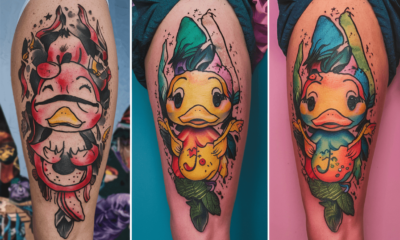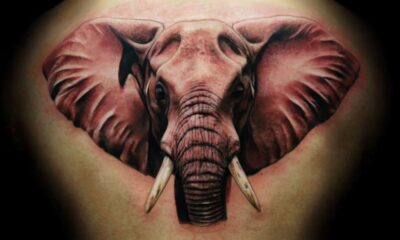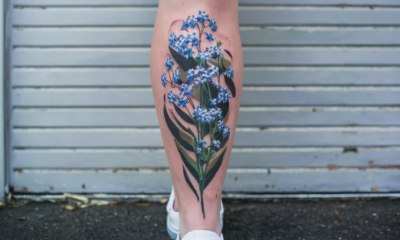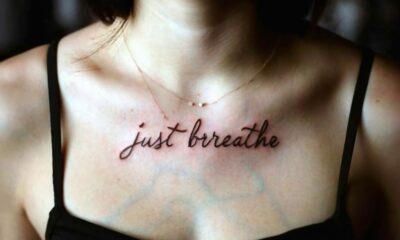Tattoos
Tattoo Transfer Paper The Magic Behind Flawless Tattoos

The hardest part of the tattooing process may be explaining the specifics of the design you want to your tattoo artist. For that reason alone, many people think about having tattoos a thousand times before doing so. Since getting a tattoo means having it on your body for the rest of your life, some people may find it scary. Ultimately, they believe they won’t get what they want.
Have you ever wondered how an artist could create a tattoo with such a detailed and flawless style without making a single error?
For this, they employ transfer paper. A piece of paper that instantly transfers the design you want into your skin, providing you with a specific tattoo sample structure. Let’s look into the various types of this magic and its functions!
What is a tattoo transfer paper?
An attractive image is a vital part of life for tattoo lovers. They confidently select an image they wish to have on their skin. The only issue is that the image on the skin needs to be precisely what they want.
Tattoo transfer paper is the solution to that issue. Carbon copy paper prints the design laid out on your skin for tattoos. This technique is the latest form of tattoo art and is a great way to avoid cutting the client’s skin off by drawing incorrect lines there without first sketching something out.
Important factors
Previously, anyone could hire a professional tattoo artist to draw their desired design. However, the issue remains: how will it look when inked onto the skin?
In a recent study, forty per cent of participants regretted how their tattoos looked.
For this reason, the newest technology available, tattoo transfer paper, can modernly deal with many problems like these.
- Using tattoo transfer paper can increase the likelihood that your tattoo will resemble your original artwork.
- In seconds, tattoo transfer paper recreates your dream image precisely on your skin.
- It provides an exclusive and accessible design for the client and artist to work on clearly and accurately.
- It may work better on complex patterns with many details and detailed artwork with tricky curves.
- This gives clients a precise understanding of their tattoo’s placement, size, and final appearance following the inking process.
- Since it is only a printed patch and not a permanent tattoo, the client can feel more at ease if they wish to alter their tattoo’s size, style, or location.
Its types
Tattoo transfer paper comes in two varieties: hectograph and thermal. The second one significantly differs from the first, lacking a thermal copier. Using thermal paper, however, could result in much higher image quality.
Thermographic Tattoo Transfer Paper
Using this type of paper and transferring with your hands or freehand is one of the options. To do this the best way possible, one needs a transfer pencil. A skilled tattoo artist should know the time and cost savings associated with thermal printing.
Continue reading, and you’ll see that the image is transferred from one area to another using heat.
Usually, thermal stencil paper has four layers:
- The image is placed on the white layer.
- A thin, milky layer that is typically discarded.
- The ink layer is often purple but can be red if you use the ground-breaking red stencil paper from S8.
- The final yellow layer secures the piece using a stencil copy machine.
The ideal combination is achieved when using thermal paper and a thermal printer. This is the best method for transferring all colours and distinct lines onto paper and, consequently, onto the skin. The body retains all of its rich details. Before the invention of S8’s ground-breaking red thermal stencil paper, the skin was typically a standard purple, which made it difficult to see on some people, particularly black people.
Hectograph/Freehand tattoo transfer paper
These typewriters from the past are the source of this particular transfer paper. A hectograph or freehand paper applies pressure to produce a duplicate image for the transfer. That makes a lot of sense when you consider how those vintage typewriters operate—with the keys striking the paper in the appropriate shape. Since manual typewriters are no longer used, the printing industry no longer utilizes them; instead, they’re mainly produced for the tattoo industry.
Three layers are commonly found on hectograph or freehand tattoo stencil paper:
- Top layer for printing or drawing.
- The center tissue layer should be removed before use to prevent the transfer paper from sticking too soon.
- The bottom layer is covered with the stencil.
The focal point serves as a barrier. The first step in tattooing is for the artist to print the design onto a hard, clean surface. Consequently, the back of the white paper will have the stencil. The drawback of hectograph paper is that lining up the skin in the absence of a dot matrix printer takes longer. These days, it is nearly impossible to find even one because they date back to the 1990s.
How to use tattoo transfer paper
An Easy-to-Use Guide for Applying Tattoo Transfer Paper:
Step-1
Sketch the desired design using a pencil on a standard piece of paper. As you won’t be able to alter it later, it should be just as you wish.
Step-2
Place the patterned paper underneath the carbon paper. There are three layers to the tattoo transfer paper. The lowest layer places all the sheets in position. A black carbon paper sheet makes up the second layer, and the sheet with the transferred design will be on top of the layer beneath it. Position the design above the bottom layer but below the second.
Step-3
Utilize a maker of thermographic transfers. The papers must pass through the design to transfer to the upper layer. Tattoo parlours sell this machine; however, remember that some neighbourhood parlours might have a machine available for use free of charge.
Step-4
Take the resultant copy out of the entire stack of documents.
Step-5
Cleanse the desired tattoo location on your body. And wash with soapy bubble water.
Step-6
Press down on the design-covered paper after placing it on the skin. For the design to fully transfer to the skin, soften the area before taking it off.
Now, if you are satisfied, take the tissue off.
If you’re not happy with the outcome, repeat the process. The thick mixture of 100 grams of salt and lemon juice can wash away failed attempts.
Sum up
The 21st century’s rapid technological advancements have made getting a tattoo easier. Your tattoo artist can now precisely outline your skin’s design and apply it to the finest detail. Transparent tattoo ink helps copy the desired artwork.
Before getting the tattoo, you can sketch the desired design and make the necessary corrections. Transferring the design from paper to skin only takes six steps. That is how you can quickly get the ideal tattoo design using the most cutting-edge method.

-

 Tattoos9 months ago
Tattoos9 months agoDuck tattoos 35+ Ideas with amazing designs and details
-

 Tattoos9 months ago
Tattoos9 months agoElephant Tattoos Symbolism, Design, and Placement Guide
-

 Tattoos8 months ago
Tattoos8 months ago“Forget me not” tattoo – Mystery behind the flower
-

 Tattoos6 months ago
Tattoos6 months agoInspiring God Tattoo Ideas: Designs That Speak to Your Faith and Spirituality
-

 Tattoos9 months ago
Tattoos9 months agoExploring the Depth of Meaning Behind Flower of Life Tattoos
-

 Tattoos9 months ago
Tattoos9 months agoHakuna Matata Embracing the Spirit of Meaningful Tattoo Designs
-

 Tattoos6 months ago
Tattoos6 months agoCreative Dropkick Murphy Rose Tattoo Ideas for Fans
-

 Tattoos9 months ago
Tattoos9 months agoThe Delightful “Just Breathe” Tattoo
